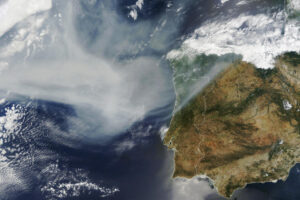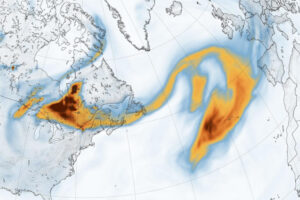JUNE 27, 2023

Smoke from Canadian wildfires is seen reaching Europe in this satellite photo June 26, 2023. / Credit: NASA Earth Observatory
The thick haze that recently blanketed much of the northeastern U.S. may have dissipated, but the problem at its root is far from over. On Tuesday, scientists warned that the wildfires in Canada have generated “record levels of emissions” that have now sent a smoke plume across the Atlantic to Europe.
In a report by Copernicus — the European Union’s program that observes Earth — scientists said that the Canadian wildfires have only intensified throughout June. The fires have been so intense that the fire radiative power emitted for the entire country was “significantly higher” in the first three weeks of June than the average from the past 20 years. There have also been an estimated 100 megatons of carbon emissions from the wildfires.
These have comprised “record levels of emissions,” Copernicus said, and make up “the largest annual estimated emissions for Canada in the 21 years of our [Global Fire Assimilation System] dataset,” which dates back to 2003.
That air pollution took a massive toll on the U.S. in the past few weeks, with the smoke causing extremely poor levels of air quality. And that impact is far from over. Copernicus forecasters said on Tuesday that smoke from Canada hit Europe on Monday, and is expected to keep moving east through Thursday.
As of Monday, there were 493 active fires across Canada that have burned more than 7.7 million hectares (19 million acres) of land, according to the Canadian Interagency Forest Fire Centre. At least 259 of those fires remain “out of control,” officials said in their latest dashboard numbers, which were updated on Monday.
Copernicus said that the fires in Quebec and Ontario intensified last week, leading to what appears to be a “strong episode of long-range smoke transport crossing the North Atlantic and reaching Europe.”

Smoke from Canadian wildfires is seen reaching Europe in this satellite photo June 26, 2023. / Credit: NASA Earth Observatory
Mark Parrington, a senior scientist with the Copernicus Atmosphere Monitoring Service, said the emissions and intensity of the Canadian wildfires have been nothing short of “unusual” when compared to the last two decades of data. But the transport of smoke associated with it, he said, is expected.
“The long-range transport of smoke that we are currently monitoring is not unusual, and not expected to have any significant impact on surface air quality in Europe,” Parrington said, “but it is a clear reflection of the intensity of the fires that such high values of aerosol optical depth and other pollutants associated with the plume are so high as it reaches this side of the Atlantic.”
This wildfire season in Canada has proven to be a rare one thus far – and even one of the worst in the country’s history.

The smoke cloud produced by the multiple wildfires in Quebec is seen over the Cies Islands next to the coast of Vigo, northwestern Spain, on June 26, 2023. / Credit: Miguel Riopa/AFP via Getty Images
“We are currently living through devastating wildfires across the country during one of the worst wildfire seasons on record,” Minister of Health Jean-Yves Duclos said in a recent news release. “…During these times, we should all take the necessary actions to protect our health and wellbeing, including knowing the air quality in our communities and reducing exposure to wildfire smoke.”
Courtesy/Source: CBS News

































































































